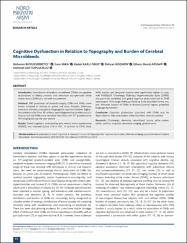Cognitive dysfunction in relation to topography and burden of cerebral microbleeds

Göster/
Erişim
info:eu-repo/semantics/openAccessTarih
2018Yazar
Büyükşerbetçi, GülserenSaka, Esen
Oğuz, Kader Karlı
Göçmen, Rahşan
Arsava, Ethem Murat
Topçuoğlu, Mehmet Akif
Üst veri
Tüm öğe kaydını gösterÖzet
Introduction: Contribution of cerebral microbleeds (CMBs) on cognitive dysfunctions in elderly patients with otherwise asymptomatic white matter lesions (WMLs) is not well-documented.
Methods: MRI parameters of cerebral atrophy. CMBs and WMLs were herein analyzed in relation to global and main domains (attention, executive, memory, visuospatial, language) of cognitive function. Eightyfive patients older than 50, without neurodegenerative/cerebrovascular disease, but had CMBs were recruited from 2562 with T2*-gradient-echo MR imaging during one-year period.
Results: Global cognition, evaluated by mini-mental status examination (MMSE), was impaired (score <= 24) in 42%. In contrast to CMBs load, WML burden and temporal atrophy were significantly higher in cases with MMSE <= 24. Cholinergic Pathways Hyperintensities Scale (CHIPS) was positively correlated with global cognitive dysfunction but its CMB counterpart, Cholinergic Pathways Bleeding Scale described herein, was not. However, burden of CMBs in thalamic/cortical regions predicted language dysfunction.
Conclusion: Cognitive dysfunction associated with CMBs may be dependent on their distribution rather than their absolute number.

















